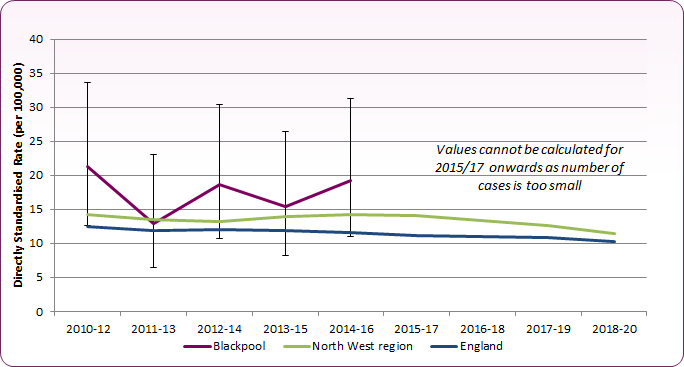Child Mortality
Last Modified 20/11/2023 13:11:18
Share this page
Introduction
Death in childhood represents not only a tragedy for that child's family but also a loss to wider society in terms of lost years of productive life.
Facts and Figures
Up to 2014-15 Blackpool experienced higher than average mortality rates for children; however the actual number of deaths each year is small which means the rates are subject to large annual variation and need to be interpreted with caution. A further reduction in deaths from 2015-17 means that it has not been possible to calculate Blackpool's child mortality rate in recent years.
Figure 1: Trend in child mortality (1-17 years), 2010-12 to 2018-20
 Source: OHID Public Health Profiles, Overview of Child Health
Source: OHID Public Health Profiles, Overview of Child Health
The data represents the directly standardised mortality rate (DSR) per 100,000 young people aged 1 to 17 years old, in Blackpool, the North West, and England. The data in Figure 1 is grouped into three year periods to mitigate for the small number of deaths in a single year. Due to the small numbers involved it is not possible to say with statistical confidence that Blackpool has a greater infant mortality rate than the North West or England as a whole. In the three years from 2014-16, 16 young people aged 1 to 17 years died in Blackpool. In the period 2015-17 this figure fell to 8 deaths, and in the periods 2017-19 and 2018-20 there were 4 deaths.
Risk Factors
Children (one to nine years)
Mortality rates among one to nine year olds in the UK declined from 11.8 deaths per 100,000 in 2014 to 10 per 100,000 in 2018. The leading causes of death in the 1-4 age group are cancer, accidents (including injuries and poisonings), and congenital conditions. In the 5-9 age group the top three causes of death are cancer, respiratory causes, and accident (including injuries and poisonings). There is a strong association between deprivation and the risk of death throughout childhood, with children in deprived areas more likely to die1.
Young people (10 to 19 years)
There has been an increase in mortality among adolescents in the UK since 2014, from 17.5 to 18.0 per 100,000 young people aged 10 to 19 years in 2018. In 2018 the most common causes of death for this age group were accidental injury, cancer and intentional self-harm (including suicide), followed by neurological, cardiovascular and respiratory disorders. The majority of these deaths are among 15- to 19-year-olds; and the risk of dying for young men is notably higher than for young women. Deprivation and mental health problems increase the risk of death throughout adolescence1.
Child death overview panel
For the Blackpool, Lancashire and Blackburn with Darwen region, the deaths of all children under the age of 18 are reviewed by the Child Death Overview Panel (CDOP) which is administered through the Children’s Safeguarding Assurance Partnership. The main purpose of the panel is to identify lessons and prevent future child deaths. The Children's Safeguarding Assurance Partnership website has the most recent CDOP report.
National and local strategies
[] Royal College of Paediatrics and Child Health (2020) State of Child Health. London: RCPCH. [Available at: stateofchildhealth.rcpch.ac.uk]